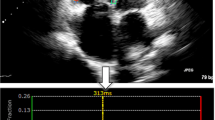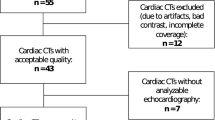Abstract
The importance of left ventricular (LV) global longitudinal strain (GLS) is increasingly recognized in multiple clinical scenarios. However, in patients with poor image quality, strain is difficult or impossible to measure without contrast enhancement. The feasibility of contrast-enhanced GLS measurement was recently demonstrated. We sought to determine: (1) whether contrast enhancement improves the accuracy of GLS measurements against cardiac magnetic resonance (CMR) reference, (2) their reproducibility compared to non-enhanced GLS, and (3) the dependence of accuracy and reproducibility on image quality. We prospectively enrolled 25 patients undergoing clinically indicated CMR imaging who subsequently underwent transthoracic echocardiography (TTE) with and without low-dose contrast injection (1–2 mL Optison/3–5 mL saline IV, GE Healthcare). GLS was measured from both non-contrast and contrast-enhanced images using speckle tracking (EchoInsight, Epsilon Imaging). These measurements were compared to each other and to CMR reference values obtained using feature tracking (SuiteHEART, NeoSoft). Inter-technique comparisons included linear regression and Bland–Altman analyses. A random subgroup of 15 patients was used to assess inter- and intra-observer variability using intra-class correlation (ICC). Contrast-enhanced GLS was in close agreement with non-enhanced GLS (r = 0.95; bias: − 0.2 ± 1.5%). Both inter-observer (ICC = 0.88 vs. 0.82) and intra-observer variability (ICC = 0.91 vs. 0.88) were improved by contrast enhancement. The agreement with CMR was better for contrast-enhanced GLS (r = 0.87; bias: 1.1 ± 2.2%) than for non-enhanced GLS (r = 0.80; bias: 1.3 ± 2.7%). In 12/25 patients with suboptimal TTE images that rendered GLS difficult to measure, contrast-enhanced GLS showed better agreement with CMR than non-enhanced GLS (r = 0.88 vs. 0.83) and also improved inter-observer (ICC = 0.83 vs. 0.76) and intra-observer variability (ICC = 0.88 vs. 0.82). In conclusion, contrast enhancement of TTE images improves the accuracy and reproducibility of GLS measurements, resulting in better agreement with CMR, even in patients with suboptimal acoustic windows. This approach may aid in the assessment of LV function in this patient population.




Similar content being viewed by others
Abbreviations
- CMR:
-
Cardiac magnetic resonance
- EF:
-
Ejection fraction
- GLS:
-
Global longitudinal strain
- ICC:
-
Intraclass correlation
- LV:
-
Left ventricular
References
Cho GY, Marwick TH, Kim HS, Kim MK, Hong KS, Oh DJ (2009) Global 2-dimensional strain as a new prognosticator in patients with heart failure. J Am Coll Cardiol 54:618–624
Leitman M, Lysyansky P, Sidenko S, Shir V, Peleg E, Binenbaum M et al (2004) Two-dimensional strain-a novel software for real-time quantitative echocardiographic assessment of myocardial function. J Am Soc Echocardiogr 17:1021–1029
Mignot A, Donal E, Zaroui A, Reant P, Salem A, Hamon C et al (2010) Global longitudinal strain as a major predictor of cardiac events in patients with depressed left ventricular function: a multicenter study. J Am Soc Echocardiogr 23:1019–1024
Serri K, Reant P, Lafitte M, Berhouet M, Le Bouffos V, Roudaut R et al (2006) Global and regional myocardial function quantification by two-dimensional strain: application in hypertrophic cardiomyopathy. J Am Coll Cardiol 47:1175–1181
Stanton T, Leano R, Marwick TH (2009) Prediction of all-cause mortality from global longitudinal speckle strain: comparison with ejection fraction and wall motion scoring. Circ Cardiovasc Imaging 2:356–364
Syeda B, Hofer P, Pichler P, Vertesich M, Bergler-Klein J, Roedler S et al (2011) Two-dimensional speckle-tracking strain echocardiography in long-term heart transplant patients: a study comparing deformation parameters and ejection fraction derived from echocardiography and multislice computed tomography. Eur J Echocardiogr 12:490–496
Takahashi M, Harada N, Isozaki Y, Lee K, Yajima R, Kataoka A et al (2013) Efficiency of quantitative longitudinal peak systolic strain values using automated function imaging on transthoracic echocardiogram for evaluating left ventricular wall motion: new diagnostic criteria and agreement with naked eye evaluation by experienced cardiologist. Int J Cardiol 167:1625–1631
Lang RM, Badano LP, Mor-Avi V, Afilalo J, Armstrong A, Ernande L et al (2015) Recommendations for cardiac chamber quantification by echocardiography in adults: an update from the American Society of Echocardiography and the European Association of Cardiovascular Imaging. J Am Soc Echocardiogr 28(1–39):e14
Mor-Avi V, Lang RM, Badano LP, Belohlavek M, Cardim NM, Derumeaux G et al (2011) Current and evolving echocardiographic techniques for the quantitative evaluation of cardiac mechanics: ASE/EAE consensus statement on methodology and indications endorsed by the Japanese Society of Echocardiography. J Am Soc Echocardiogr 24:277–313
Plana JC, Galderisi M, Barac A, Ewer MS, Ky B, Scherrer-Crosbie M et al (2014) Expert consensus for multimodality imaging evaluation of adult patients during and after cancer therapy: a report from the American Society of Echocardiography and the European Association of Cardiovascular Imaging. J Am Soc Echocardiogr 27:911–939
Medvedofsky D, Lang RM, Kruse E, Guile B, Weinert L, Ciszek B et al (2018) Feasibility of left ventricular global longitudinal strain measurements from contrast-enhanced echocardiographic images. J Am Soc Echocardiogr 31:297–303
Andre F, Robbers-Visser D, Helling-Bakki A, Foll A, Voss A, Katus HA et al (2016) Quantification of myocardial deformation in children by cardiovascular magnetic resonance feature tracking: determination of reference values for left ventricular strain and strain rate. J Cardiovasc Magn Reson 19:8
Andre F, Steen H, Matheis P, Westkott M, Breuninger K, Sander Y et al (2015) Age- and gender-related normal left ventricular deformation assessed by cardiovascular magnetic resonance feature tracking. J Cardiovasc Magn Reson 17:25
Aurich M, Keller M, Greiner S, Steen H, Aus dem Siepen F, Riffel J et al (2016) Left ventricular mechanics assessed by two-dimensional echocardiography and cardiac magnetic resonance imaging: comparison of high-resolution speckle tracking and feature tracking. Eur Heart J Cardiovasc Imaging 17:1370–1378
de Siqueira ME, Pozo E, Fernandes VR, Sengupta PP, Modesto K, Gupta SS et al (2016) Characterization and clinical significance of right ventricular mechanics in pulmonary hypertension evaluated with cardiovascular magnetic resonance feature tracking. J Cardiovasc Magn Reson 18:39
Dick A, Schmidt B, Michels G, Bunck AC, Maintz D, Baessler B (2017) Left and right atrial feature tracking in acute myocarditis: a feasibility study. Eur J Radiol 89:72–80
Obokata M, Nagata Y, Wu VC, Kado Y, Kurabayashi M, Otsuji Y et al (2016) Direct comparison of cardiac magnetic resonance feature tracking and 2D/3D echocardiography speckle tracking for evaluation of global left ventricular strain. Eur Heart J Cardiovasc Imaging 17:525–532
Pandey T, Alapati S, Wadhwa V, Edupuganti MM, Gurram P, Lensing S et al (2017) Evaluation of myocardial strain in patients with amyloidosis using cardiac magnetic resonance feature tracking. Curr Probl Diagn Radiol 46:288–294
Schmidt B, Dick A, Treutlein M, Schiller P, Bunck AC, Maintz D et al (2017) Intra- and inter-observer reproducibility of global and regional magnetic resonance feature tracking derived strain parameters of the left and right ventricle. Eur J Radiol 89:97–105
Taylor RJ, Moody WE, Umar F, Edwards NC, Taylor TJ, Stegemann B et al (2015) Myocardial strain measurement with feature-tracking cardiovascular magnetic resonance: normal values. Eur Heart J Cardiovasc Imaging 16:871–881
Macron L, Lairez O, Nahum J, Berry M, Deal L, Deux JF et al (2011) Impact of acoustic window on accuracy of longitudinal global strain: a comparison study to cardiac magnetic resonance. Eur J Echocardiogr 12:394–399
Lee KS, Honda T, Reuss CS, Zhou Y, Khandheria BK, Lester SJ (2008) Effect of echocardiographic contrast on velocity vector imaging myocardial tracking. J Am Soc Echocardiogr 21:818–823
Malm S, Frigstad S, Stoylen A, Torp H, Sagberg E, Skjarpe T (2006) Effects of ultrasound contrast during tissue velocity imaging on regional left ventricular velocity, strain, and strain rate measurements. J Am Soc Echocardiogr 19:40–47
Mulvagh SL, Rakowski H, Vannan MA, Abdelmoneim SS, Becher H, Bierig SM et al (2008) American society of echocardiography consensus statement on the clinical applications of ultrasonic contrast agents in echocardiography. J Am Soc Echocardiogr 21:1179–1201
Funding
This study was supported by a research Grant from GE Healthcare.
Author information
Authors and Affiliations
Corresponding author
Ethics declarations
Conflict of interest
All authors declare that they have no conflict of interest.
Ethical approval
All procedures performed in studies involving human participants were in accordance with the ethical standards of the institutional and/or national research committee and with the 1964 Helsinki declaration and its later amendments or comparable ethical standards.
Informed consent
Informed consent was obtained from all participants included in the study.
Additional information
Publisher's Note
Springer Nature remains neutral with regard to jurisdictional claims in published maps and institutional affiliations.
Rights and permissions
About this article
Cite this article
Karagodin, I., Genovese, D., Kruse, E. et al. Contrast-enhanced echocardiographic measurement of longitudinal strain: accuracy and its relationship with image quality. Int J Cardiovasc Imaging 36, 431–439 (2020). https://doi.org/10.1007/s10554-019-01732-4
Received:
Accepted:
Published:
Issue Date:
DOI: https://doi.org/10.1007/s10554-019-01732-4




